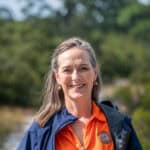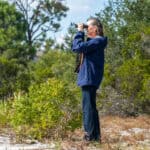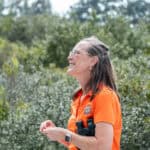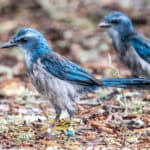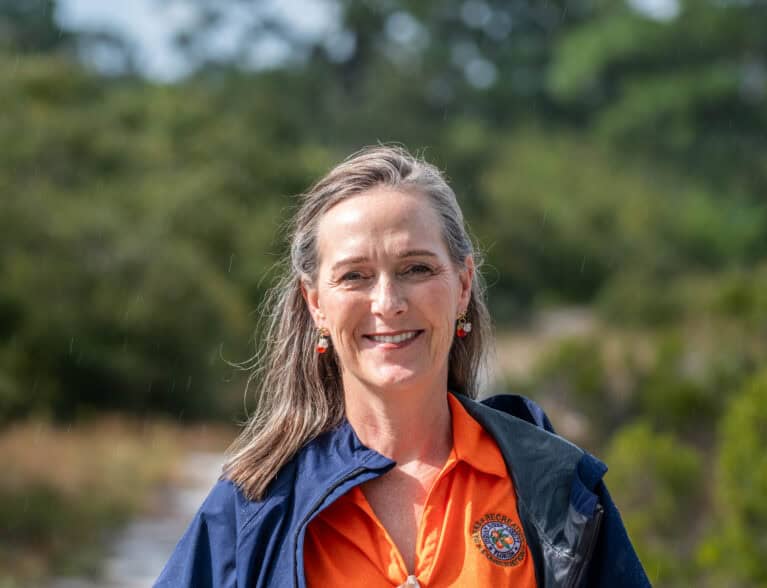
Beth Powell, Indian River County’s Director of Parks, Recreation and Conservation has received national recognition for 25 years of conservation work, including her leadership on preserving local habitat for the Florida Scrub-jay, which is protected as a threatened species under the Federal Endangered Species Act.
Powell was awarded a fully paid scholarship to attend the 2025 National Habitat Conservation Planning Conference from Oct. 14-17 at the U.S. Fish & Wildlife Service Habitat Training Center in Shepherdstown, West Virginia. Powell is the recipient of the first John Hopkins scholarship, named for the founder of the National Habitat Planning Coalition, which hosted the event.
In addition to hearing from other habitat conservation professionals from around the country, Powell shared a presentation about her work administering the county’s Sebastian Area-wide Florida Scrub-jay Habitat Conservation Plan (HCP), which, adopted in 2000, is one of the first HCPs in the state.
Between 1991 and 1998, the Sebastian area’s Scrub-jay population declined 45% — from 35 breeding pairs to just 16 pairs. The reason for the decline is habitat loss from development and habitat fragmentation from fire suppression.
Wildfire is actually good for Scrub-jay populations, as it clears out tall trees and ground vegetation, leaving “scrub” – shorter, immature trees and shrubs, such as prickly pear, hog plum, gopher apple, and some species of oak – that are preferred by Scrub-jays, hence the name. The birds thrive in scrub – nesting in taller trees leaves them prone to hawks and merlin, who hunt them for prey. Nesting lower makes them vulnerable to snakes or even housecats.
Nestlings are tiny when hatched, only about the size of the tip of a human thumb. Parents feed the nestlings insect larvae, which are high in protein, from under scrub oak leaves. As they mature, the birds eat insects, berries and even snakes and lizards during the summer months and store caches of acorns under the white sugar sand for meals in the winter months.
The lack of naturally occurring wildfires have caused families to become separated from each other, along with construction of roads, golf courses, and major developments.
When Powell started managing the Scrub-jay population in 2000, there were about 10 families. Today, thanks to management, mapping, banding and monitoring Scrub-jays, there are 110 family groups, with two to six birds in each group, she said. Her department now manages five conservation areas:
- North Sebastian Scrub Conservation Area, 406 acres west of U.S. 1 between Roseland Road to the south and Main Street to the north.
- Sebastian Highlands Conservation Area, 10 acres located off Thunderbird Drive.
- Wabasso Scrub Preservation Area, 111 acres at 8900 64th Ave., Sebastian.
- Pelican Island Elementary School Scrub-jay Preserve, 12 acres behind the school at 1355 Schumann Drive, Sebastian.
- Sebastian Airport Scrub Conservation Area, 30 acres near the airport.
All but the Airport Conservation Area are open to the public.
“We have the most amazing HCP,” Powell said. “The people who wrote it had a vision of what could happen in the future in this urban area.”
At the time, conservationists didn’t know if the birds could cross the St. Sebastian River and into the 22,000-acre St. Sebastian River Preserve State Park, Powell said. “Scrub-jays typically only travel up to two miles from where they’re born. Part of the HCP was to build a corridor to the park,” she said. Today, about 55 families have migrated to the state park, she said.
This migration, albeit over a short distance, is important for genetic diversity, Powell said. “Without that diversity, the species becomes more susceptible to disease.”
HCPs are plans to mitigate the impact on Florida Scrub-jays through Incidental Take Permits (ITPs), which allow for the “take” of scrub-jay habitat during development projects by requiring developers to contribute to conservation efforts elsewhere. Indian River County’s ITP, acquired in 2000, expires in five years.
“I’ve got to give kudos to staff and leadership,” Powell said. “We’ve now mitigated 14,000 lots in the Sebastian Highlands area, released under our ITP. This is literally what sustainable development looks like.”
Voters have indicated that such preservation efforts are important, Powell said. When formulating the county’s Parks and Recreation Master Plan, residents told the county over and over again how important it was to them, she said.
“We have a lot to be proud of in Indian River County,” Powell said.
But there’s more work to be done. As the county continues to obtain conservation lands through its voter-approved $50 million Environmental Lands Program, more staff will be needed to manage it all, Powell said. Currently, five of her overall staff of 165 are dedicated to conservation efforts.
On of the challenges is a rumored staff cutback at the U.S. Department of Interior (DOI) as a result of the Trump Administration’s Department of Government Efficiency (DOGE) efforts, Powell said. Her staff works with scientists from the Department of Interior to maintain compliance with the Endangered Species Act.
“We will have a harder time navigating that pathway if there are significant cuts to DOI staff,” she said.
Photos by Joshua Kodis

